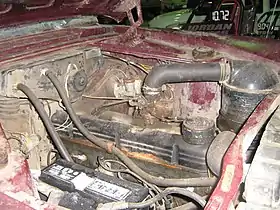Ford Zephyr engine
Ford's revolutionary United Kingdom Zephyr/Consul cars used a new family of engines. The so-called Zephyr engine included both straight-4 and straight-6 OHV engines. Production began in 1951 and lasted through to 1966, when it was replaced by Ford's Essex V4 and Essex V6 engines.
| Ford Zephyr engine | |
|---|---|
 | |
| Overview | |
| Manufacturer | Ford Motor Company |
| Production | 1951-1966 |
| Layout | |
| Configuration | Straight-4 and Straight-6 |
| Displacement | 1.5–2.6 L; 91.8–155.8 cu in (1,505–2,553 cc) |
| Cylinder bore | 79.3 mm (3.12 in) 82.5 mm (3.25 in) |
| Piston stroke | 76.2 mm (3.00 in) 79.5 mm (3.13 in) |
| Valvetrain | OHV |
| Combustion | |
| Fuel type | Petrol |
| Cooling system | Water-cooled |
| Output | |
| Power output | 47–71 bhp (35–53 kW) |
| Chronology | |
| Successor | Essex V4, Essex V6 |
Consul/Zephyr 4
The straight-4 engine started in 1951 at 1.5 L; 91.8 cu in (1,505 cc). In this form it had a bore and stroke of 79.3 mm × 76.2 mm (3.12 in × 3.00 in). With its standard compression ratio of 6.8:1 it produced an output of 47 bhp (35 kW) at 4400 rpm. It was enlarged in 1956 to 1.7 L (100 cu in) engine for the Mark II Consul by increasing both the bore and stroke to 82.5 mm × 79.5 mm (3.25 in × 3.13 in), putting the power up to 59 bhp (44 kW). This engine continued in the Mark III car, now called Zephyr.
Automobiles using the Consul engine:
Zephyr 6
The straight-6 Zephyr engine was used widely. Displacement began at 2.3 L; 137.8 cu in (2,258 cc) when it shared the same bore and stroke as the 1.5 L; 91.8 cu in (1,505 cc) 4-cylinder engine. It was produced with two standard compression ratios of 6.8:1 and 7.5:1 with outputs of 68 and 71 bhp (51 and 53 kW). It grew to 2.6 L; 155.8 cu in (2,553 cc) in the 1956 Mark II.